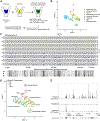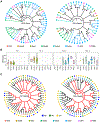Simultaneous brain cell type and lineage determined by scRNA-seq reveals stereotyped cortical development
- PMID: 35452605
- PMCID: PMC9233029
- DOI: 10.1016/j.cels.2022.03.006
Simultaneous brain cell type and lineage determined by scRNA-seq reveals stereotyped cortical development
Abstract
Mutations are acquired frequently, such that each cell's genome inscribes its history of cell divisions. Common genomic alterations involve loss of heterozygosity (LOH). LOH accumulates throughout the genome, offering large encoding capacity for inferring cell lineage. Using only single-cell RNA sequencing (scRNA-seq) of mouse brain cells, we found that LOH events spanning multiple genes are revealed as tracts of monoallelically expressed, constitutionally heterozygous single-nucleotide variants (SNVs). We simultaneously inferred cell lineage and marked developmental time points based on X chromosome inactivation and the total number of LOH events while identifying cell types from gene expression patterns. Our results are consistent with progenitor cells giving rise to multiple cortical cell types through stereotyped expansion and distinct waves of neurogenesis. This type of retrospective analysis could be incorporated into scRNA-seq pipelines and, compared with experimental approaches for determining lineage in model organisms, is applicable where genetic engineering is prohibited, such as humans.
Keywords: LOH; X-inactivation; brain development; cell fate; lineage; loss of heterozygosity.
Copyright © 2022 Elsevier Inc. All rights reserved.
Conflict of interest statement
Declaration of interests The authors declare no competing interests.
Figures





Similar articles
-
Bayesian Phylogenetic Lineage Reconstruction with Loss of Heterozygosity Mutations Derived from Single-Cell RNA Sequencing.Methods Mol Biol. 2025;2886:1-22. doi: 10.1007/978-1-0716-4310-5_1. Methods Mol Biol. 2025. PMID: 39745633
-
Parallel RNA and DNA analysis after deep sequencing (PRDD-seq) reveals cell type-specific lineage patterns in human brain.Proc Natl Acad Sci U S A. 2020 Jun 23;117(25):13886-13895. doi: 10.1073/pnas.2006163117. Epub 2020 Jun 10. Proc Natl Acad Sci U S A. 2020. PMID: 32522880 Free PMC article.
-
Genetic Evaluation of Copy Number Variations, Loss of Heterozygosity, and Single-Nucleotide Variant Levels in Human Embryonic Stem Cells With or Without Skewed X Chromosome Inactivation.Stem Cells Dev. 2015 Aug 1;24(15):1779-92. doi: 10.1089/scd.2014.0463. Epub 2015 May 26. Stem Cells Dev. 2015. PMID: 25919240
-
Deciphering cell-cell interactions and communication in the tumor microenvironment and unraveling intratumoral genetic heterogeneity via single-cell genomic sequencing.Bioengineered. 2022 Jul-Dec;13(7-12):14974-14986. doi: 10.1080/21655979.2023.2185434. Bioengineered. 2022. PMID: 37105769 Free PMC article. Review.
-
Generation of loss of heterozygosity and its dependency on p53 status in human lymphoblastoid cells.Environ Mol Mutagen. 2005 Mar-Apr;45(2-3):162-76. doi: 10.1002/em.20113. Environ Mol Mutagen. 2005. PMID: 15688360 Review.
Cited by
-
Stereotyped Subclones Revealed by High-Density Single-Cell Lineage Tracing Support Robust Development.Adv Sci (Weinh). 2025 Aug;12(30):e2406208. doi: 10.1002/advs.202406208. Epub 2025 Apr 30. Adv Sci (Weinh). 2025. PMID: 40307991 Free PMC article.
-
Multi-view clustering for single-cell RNA-seq data based on graph fusion.Brief Bioinform. 2025 May 1;26(3):bbaf193. doi: 10.1093/bib/bbaf193. Brief Bioinform. 2025. PMID: 40413869 Free PMC article.
-
Widespread Gene Editing in the Brain via In Utero Delivery of mRNA Using Acid-Degradable Lipid Nanoparticles.ACS Nano. 2024 Nov 5;18(44):30293-30306. doi: 10.1021/acsnano.4c05169. Epub 2024 Oct 24. ACS Nano. 2024. PMID: 39445691 Free PMC article.
-
Bayesian Phylogenetic Lineage Reconstruction with Loss of Heterozygosity Mutations Derived from Single-Cell RNA Sequencing.Methods Mol Biol. 2025;2886:1-22. doi: 10.1007/978-1-0716-4310-5_1. Methods Mol Biol. 2025. PMID: 39745633
-
The landscape of cell lineage tracing.Sci China Life Sci. 2025 Jul;68(7):1941-1963. doi: 10.1007/s11427-024-2751-6. Epub 2025 Feb 28. Sci China Life Sci. 2025. PMID: 40035969 Review.
References
-
- Auwera GA, Carneiro MO, Hartl C, Poplin R, del Angel G, Levy-Moonshine A, Jordan T, Shakir K, Roazen D, Thibault J, et al. (2013). From FastQ Data to High-Confidence Variant Calls: The Genome Analysis Toolkit Best Practices Pipeline. Current Protocols in Bioinformatics 43, 11.10.1–11.10.33. - PMC - PubMed
Publication types
MeSH terms
Grants and funding
LinkOut - more resources
Full Text Sources
Molecular Biology Databases

